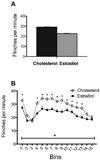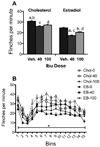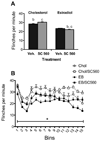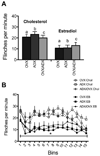Estradiol-induced antinociceptive responses on formalin-induced nociception are independent of COX and HPA activation
- PMID: 21132813
- PMCID: PMC3075311
- DOI: 10.1002/syn.20890
Estradiol-induced antinociceptive responses on formalin-induced nociception are independent of COX and HPA activation
Abstract
Estrogen modulates pain perception but how it does so is not fully understood. The aim of this study was to determine if estradiol reduces nociceptive responses in part via hypothalamic-pituitary-adrenal (HPA) axis regulation of cyclooxygenase (COX)-1/COX-2 activity. The first study examined the effects of estradiol (20%) or vehicle with concurrent injection nonsteroidal antiinflammatory drugs (NSAIDs) on formalin-induced nociceptive responding (flinching) in ovariectomized (OVX) rats. The drugs were ibuprofen (COX-1 and COX-2 inhibitor), SC560 (COX-1 inhibitor), or NS398 (COX-2 inhibitor). In a second study, estradiol's effects on formalin-induced nociception were tested in adrenalectomized (ADX), OVX, and ADX+OVX rats. Serum levels of prostaglandins (PG) PGE(2) and corticosterone were measured. Estradiol significantly decreased nociceptive responses in OVX rats with effects during both the first and the second phase of the formalin test. The nonsteroidal antiinflammatory drugs (NSAIDs) did not alter nociception at the doses used here. Adrenalectomy neither altered flinching responses in female rats nor reversed estradiol-induced antinociceptive responses. Estradiol alone had no effect on corticosterone (CORT) or prostaglandin levels after the formalin test, dissociating the effects of estradiol on behavior and these serum markers. Ibuprofen and NS398 significantly reduced PGE2 levels. CORT was not decreased by OVX surgery or by estradiol below that of ADX. Only IBU significantly increased corticosterone levels. Taken together, our results suggest that estradiol-induced antinociception in female rats is independent of COX activity and HPA axis activation.
Copyright © 2010 Wiley-Liss, Inc.
Figures





Similar articles
-
Estrogen alters baseline and inflammatory-induced cytokine levels independent from hypothalamic-pituitary-adrenal axis activity.Cytokine. 2015 Apr;72(2):121-9. doi: 10.1016/j.cyto.2015.01.007. Epub 2015 Jan 31. Cytokine. 2015. PMID: 25647266 Free PMC article.
-
Long-term ovariectomy changes formalin-induced licking in female rats: the role of estrogens.Reprod Biol Endocrinol. 2003 Feb 14;1:24. doi: 10.1186/1477-7827-1-24. Reprod Biol Endocrinol. 2003. PMID: 12646052 Free PMC article.
-
Estrogen impairs glucocorticoid dependent negative feedback on the hypothalamic-pituitary-adrenal axis via estrogen receptor alpha within the hypothalamus.Neuroscience. 2009 Mar 17;159(2):883-95. doi: 10.1016/j.neuroscience.2008.12.058. Epub 2009 Jan 7. Neuroscience. 2009. PMID: 19166915 Free PMC article.
-
Dopamine-beta-hydroxylase activity is necessary for hypothalamo-pituitary-adrenal (HPA) responses to ether, and stress-induced facilitation of subsequent HPA responses to acute ether emerges as HPA responses are inhibited by increasing corticosterone (B).J Neuroendocrinol. 1997 Aug;9(8):601-8. doi: 10.1046/j.1365-2826.1997.00613.x. J Neuroendocrinol. 1997. PMID: 9283048
-
Nitric oxide and prostaglandin systems in the stimulation of hypothalamic-pituitary-adrenal axis by neurotransmitters and neurohormones.J Physiol Pharmacol. 2004 Dec;55(4):679-703. J Physiol Pharmacol. 2004. PMID: 15613736 Review.
Cited by
-
Oxylipins as Biomarkers for Aromatase Inhibitor-Induced Arthralgia (AIA) in Breast Cancer Patients.Metabolites. 2023 Mar 20;13(3):452. doi: 10.3390/metabo13030452. Metabolites. 2023. PMID: 36984892 Free PMC article.
-
Estrogen alters baseline and inflammatory-induced cytokine levels independent from hypothalamic-pituitary-adrenal axis activity.Cytokine. 2015 Apr;72(2):121-9. doi: 10.1016/j.cyto.2015.01.007. Epub 2015 Jan 31. Cytokine. 2015. PMID: 25647266 Free PMC article.
-
Sex differences and hormonal modulation of deep tissue pain.Front Neuroendocrinol. 2013 Oct;34(4):350-66. doi: 10.1016/j.yfrne.2013.07.002. Epub 2013 Jul 17. Front Neuroendocrinol. 2013. PMID: 23872333 Free PMC article. Review.
-
Estrogen receptor β activation is antinociceptive in a model of visceral pain in the rat.J Pain. 2012 Jul;13(7):685-94. doi: 10.1016/j.jpain.2012.04.010. Epub 2012 Jun 13. J Pain. 2012. PMID: 22698981 Free PMC article.
-
Interactions of estradiol and NSAIDS on carrageenan-induced hyperalgesia.Brain Res. 2011 Mar 25;1382:181-8. doi: 10.1016/j.brainres.2011.01.075. Epub 2011 Jan 31. Brain Res. 2011. PMID: 21281615 Free PMC article.
References
-
- Amandusson A, Blomqvist A. Estrogen receptor-alpha expression in nociceptive-responsive neurons in the medullary dorsal horn of the female rat. Eur J Pain. 2009;14(3):245–248. - PubMed
-
- Averbuch M, Katzper M. A search for sex differences in response to analgesia. Arch Intern Med. 2000;160(22):3424–3428. - PubMed
-
- Borzan J, Fuchs PN. Organizational and activational effects of testosterone on carrageenan-induced inflammatory pain and morphine analgesia. Neuroscience. 2006;143(3):885–893. - PubMed
-
- Bradshaw HB, Berkley KJ. Estrogen replacement reverses ovariectomy-induced vaginal hyperalgesia in the rat. Maturitas. 2002;41:157–165. - PubMed
Publication types
MeSH terms
Substances
Grants and funding
- DA-12136/DA/NIDA NIH HHS/United States
- UL1 RR024996/RR/NCRR NIH HHS/United States
- DA-000325/DA/NIDA NIH HHS/United States
- DA-001457/DA/NIDA NIH HHS/United States
- K05 DA000198/DA/NIDA NIH HHS/United States
- G12 RR003037/RR/NCRR NIH HHS/United States
- R01 DA001457/DA/NIDA NIH HHS/United States
- DA-000198/DA/NIDA NIH HHS/United States
- NF-39534/PHS HHS/United States
- P60 DA005130/DA/NIDA NIH HHS/United States
- K02 DA000325/DA/NIDA NIH HHS/United States
- NS-341073/NS/NINDS NIH HHS/United States
- RR-03037/RR/NCRR NIH HHS/United States
- R24 DA012136/DA/NIDA NIH HHS/United States
LinkOut - more resources
Full Text Sources
Medical
Research Materials
